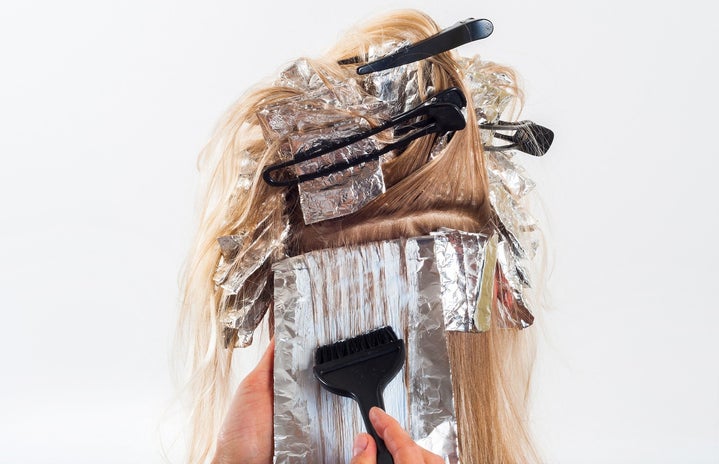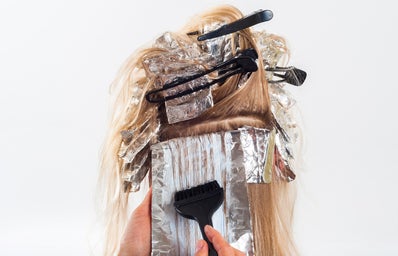After many years of feeling unsatisfied with my natural brunette hue, I realized that I wanted something more for my hair. I was someone that required constant change and I struggled to settle on the same experience more than once. My hair-coloring obsession began with partial highlights and from there, over the next few years, my hair blossomed and went through multiple color changes back-to-back. It got to the point where my hair would change colors every few months, and my family and friends would see a new Dani every time I came home to visit. While it was the best thing I did during quarantine, my hair crumbled under the weight of my decisions (quite literally) and I found myself searching for ways to revive my crispy, damaged locks.

The number of times I went to the salon was astonishing. I spent more money than I’m willing to admit and when my wallet couldn’t take it anymore, I switched to a makeshift salon in the comfort of my living room with the help of my friends and some materials from my friendly, neighborhood Sally’s.
Despite all the damage and hair loss that came along with this experience, I found a way to go from (almost) platinum blonde to a bright cherry red and then to my current color, a rich, dark brown all in the matter of a few months. For any other aspiring hair experimenters, like myself, I have compiled some of the most effective tips that have saved my hair and helped me thrive post-bleach and coloring.
Do your hair color research.

One of the most important things to remember is that everyone’s hair is different. The products I use on my hair might not work for the next person. I recommend understanding your specific hair type and texture before doing anything. If you have more coarse, thick hair, your hair might be less prone to breakage than someone with thin, straight hair. This will affect what hair color options are best for you and how much change your hair can really handle.
Also, hair color going in matters. Some dyes on the market like the L’Oreal HiColor Permanent Crème color line consist of dyes for dark hair. Another thing to consider is if you want semi/demi-permanent hair dye or permanent hair dye. Semi-permanent dye is less of a commitment but requires more retouches and permanent dye options normally require a 10 or 20 level developer for color correction, which can be harsher on your hair.
Stick to a routine!
Once your hair is dyed, a new routine must be put in place immediately. This should include a new shampoo and conditioner free of sulfates and parabens (preferably a color compatible brand), a leave-in conditioner for post-shower moisture, moisturizing hair masks (once or twice a week), and a gentle dry shampoo for in-between washes. Also, you should only shampoo your hair twice or three times a week, so you can avoid stripping your hair of its natural oils and minerals.
Offset your coloring budget for a nice deep conditioner.

This single-handedly saved my hair from pre-mature death. Just like you take care of your car and get an oil change and wash every once in and while, this is the same idea for your hair. A deep conditioner should be the required, occasional maintenance you do on your hair.
Invest in hair care accessories.
Aside from all the regular creams, soaps and oils, there are actual tools that can help you stimulate hair growth and prevent breakage and frizz. Although some of these might be an upfront investment, they will pay off later. I would invest in a silk pillowcase and silk hair wrap. The reason you wake up with frizz and bedhead is due to the friction and static between the pillowcase and your hair rubbing against it during sleep. This option is especially helpful for all my girls out there with frizz-prone, textured hair or people who have a natural curl pattern.
Stay away from heat if you can.
Don’t get me wrong, I love curling and straightening my hair just like any other girl does, but I’ve had to sacrifice a nice curl for the safety of my hair these days. This doesn’t mean I’ve given it up completely though. What I recommend is minimizing the number of times you apply heat to your hair if possible. If you have to, invest in a nice heat protectant and set your curler or straightener on the lowest setting (under 300 degrees depending on the tool) and take a shorter time to style the hair, so there is minimal heat exposure possible. If you really love curling your hair, look into the no heat curling options there are that only use a sock or tight!
After reading this, I hope I have given some insight into how you can save your locks if you too fell victim to impulse dying during quarantine!
Want to see more HCFSU? Be sure to like us on Facebook and follow us on Instagram, Twitter and Pinterest!



